Quantitative Evaluation of the Eco-Environment in a Coalfield Based on Multi-Temporal Remote Sensing Imagery: A Case Study of Yuxian, China
Abstract
1. Introduction
2. Study Area
3. Materials and Methods
3.1. Data Sources and Processing
3.2. Research Methods
3.2.1. Construction of the Environmental Quality Evaluation Index System
3.2.2. Weight Determination Based on a Multi-Criteria Decision-Making Technique
3.2.3. Ecological Carrying Capacity Calculation Based on the Ecological Footprint
3.2.4. Comprehensive Evaluation Model Construction
4. Results and Discussion
4.1. Index Analysis
4.2. Environmental Quality Analysis and Validation
5. Conclusions
Author Contributions
Acknowledgments
Conflicts of Interest
References
- Brown, P.H.; Magee, D.; Yilin, X.U. Socioeconomic vulnerability in China’s hydropower development. China Econ. Rev. 2008, 19, 614–627. [Google Scholar] [CrossRef]
- Cui, X.; Gao, Y.; Yuan, D. Sudden surface collapse disasters caused by shallow partial mining in Datong coalfield, China. Nat. Hazards 2014, 74, 911–929. [Google Scholar] [CrossRef]
- Wei, F.H.; Guang-Yi, A.N.; Wang, G.X.; Jie-Lin, A.N.; Kang, X.M. Mine Greening and Utilization of Abandoned Mines. J. Northwest For. Univ. 2009, 24, 217–219. [Google Scholar]
- Huang, J.; Ni, J.; Song, Y.; Wang, Y.; Zhu, G. Discussion on the Evaluation Index System for Green Mine Construction. Met. Mine 2009, 11, 043. [Google Scholar]
- Chen, W.; Li, X.; He, H.; Wang, L. A review of fine-scale land use and land cover classification in open-pit mining areas by remote sensing techniques. Remote Sens. 2017, 10, 15. [Google Scholar] [CrossRef]
- Zhang, B.; Wu, D.; Zhang, L.; Jiao, Q.; Li, Q. Application of hyperspectral remote sensing for environment monitoring in mining areas. Environ. Earth Sci. 2012, 65, 649–658. [Google Scholar] [CrossRef]
- Yun, F.; Yu, H.X. Roles of Remote Sensing Technology on Monitoring Resources and Environment and Its Trends. Remote Sens. Technol. Appl. 1999, 14, 59–70. [Google Scholar]
- Zhang, K.; Shi-Bin, M.A.; Liu, L.P. Remote Sensing Monitoring of the Mineral Resources Exploration and Mining Environment of the Salt Lake Based on SPOT5 Data. Remote Sens. Land Resour. 2012, 12, 243–254. [Google Scholar]
- Green, K.; Kempka, D.; Lackey, L. Using remote sensing to detect and monitor land-cover and land-use change. Photogramm. Eng. Remote Sens. 1994, 60, 331–337. [Google Scholar]
- Olokeogun, O.S.; Iyiola, K.; Iyiola, O.F. Application of remote sensing and GIS in land use/land cover mapping and change detection in Shasha forest reserve, Nigeria. ISPRS Int. Arch. Photogramm. Remote Sens. Spat. Inf. Sci. 2014, XL-8, 613–616. [Google Scholar] [CrossRef]
- Dewan, A.M.; Yamaguchi, Y. Using remote sensing and GIS to detect and monitor land use and land cover change in Dhaka Metropolitan of Bangladesh during 1960–2005. Environ. Monit. Assess. 2009, 150, 237–249. [Google Scholar] [CrossRef] [PubMed]
- Gonzalez-Alonso, F.; Cuevas, J.M.; Arbiol, R.; Baulies, X. Remote sensing and agricultural statistics: Crop area estimation in north-eastern Spain through diachronic Landsat TM and ground sample data. Int. J. Remote Sens. 1997, 18, 467–470. [Google Scholar] [CrossRef]
- Yang, D.W.; He, C.; Lei, H.M.; Tang, Q.; Durand, M.; Lettenmaier, D.P. Estimation of evapotranspiration using a remote sensing model over agricultural land in the North China Plain. Int. J. Remote Sens. 2010, 31, 3783–3798. [Google Scholar] [CrossRef]
- Atzberger, C. Advances in Remote Sensing of Agriculture: Context Description, Existing Operational Monitoring Systems and Major Information Needs. Remote Sens. 2013, 5, 4124. [Google Scholar] [CrossRef]
- Shah, V.V.D. Image Processing and its Military Applications. Defence Sci. J. 2014, 37, 457–468. [Google Scholar] [CrossRef]
- Fan, Y.; Wen, Q.; Wang, W.; Wang, P.; Li, L.; Zhang, P. Quantifying Disaster Physical Damage Using Remote Sensing Data—A Technical Work Flow and Case Study of the 2014 Ludian Earthquake in China. Int. J. Disaster Risk Sci. 2017, 8, 471–488. [Google Scholar] [CrossRef]
- Singh, N.P.; Mukherjee, T.K.; Shrivastava, B.B.P. Monitoring the impact of coal mining and thermal power industry on landuse pattern in and around Singrauli Coalfield using Remote Sensing data and GIS. J. Indian Soc. Remote Sens. 1997, 25, 61. [Google Scholar] [CrossRef]
- Townsend, P.A.; Helmers, D.P.; Kingdon, C.C.; Mcneil, B.E.; Beurs, K.M.D.; Eshleman, K.N. Changes in the extent of surface mining and reclamation in the Central Appalachians detected using a 1976–2006 Landsat time series. Remote Sens. Environ. 2009, 113, 62–72. [Google Scholar] [CrossRef]
- Karan, S.K.; Samadder, S.R.; Maiti, S.K. Assessment of the capability of remote sensing and GIS techniques for monitoring reclamation success in coal mine degraded lands. J. Environ. Manag. 2016, 182, 272–283. [Google Scholar] [CrossRef]
- Li, A.; Wang, A.; Liang, S.; Zhou, W. Eco-environmental vulnerability evaluation in mountainous region using remote sensing and GIS—A case study in the upper reaches of Minjiang River, China. Ecol. Model. 2006, 192, 175–187. [Google Scholar] [CrossRef]
- Harris, S.; Veraverbeke, S.; Hook, S. Evaluating spectral indices for assessing fire severity in chaparral ecosystems (Southern California) using MODIS/ASTER (MASTER) airborne simulator data. Remote Sens. 2011, 3, 2403–2419. [Google Scholar] [CrossRef]
- Tsou, J.; Gao, Y.; Zhang, Y.; Sun, G.; Ren, J.; Li, Y. Evaluating Urban Land Carrying Capacity Based on the Ecological Sensitivity Analysis: A Case Study in Hangzhou, China. Remote Sens. 2017, 9, 529. [Google Scholar] [CrossRef]
- Zhao, F.; Xu, B.; Yang, X.; Jin, Y.; Li, J.; Xia, L.; Chen, S.; Ma, H. Remote Sensing Estimates of Grassland Aboveground Biomass Based on MODIS Net Primary Productivity (NPP): A Case Study in the Xilingol Grassland of Northern China. Remote Sens. 2014, 6, 5368–5386. [Google Scholar] [CrossRef]
- Wang, X.; Tan, K.; Chen, B.; Du, P. Assessing the Spatiotemporal Variation and Impact Factors of Net Primary Productivity in China. Sci. Rep. 2017, 7, 44415. [Google Scholar] [CrossRef] [PubMed]
- Yue, D.X.; Ma, J.H.; Guo, J.J.; Zhang, J.J.; Du, J.; Song, Y.J.; Hui, C. RS & GIS-Based Spatialtemporal Analysis of Ecological Footprint and Biocapacity Pattern of Jinghe River Watershed in China: Does Supply Meet Demand? Adv. Mater. Res. 2012, 356–360, 2820–2832. [Google Scholar]
- Yue, D.; Jun, D.U.; Liu, J.; Gou, J.; Zhang, J. Spatio-temporal analysis of ecological carrying capacity in Jinghe Watershed based on Remote Sensing and Transfer Matrix. Acta Ecol. Sin. 2011, 31, 2550–2558. [Google Scholar]
- Zeng, G.; Jiang, R.; Huang, G.; Xu, M.; Li, J. Optimization of wastewater treatment alternative selection by hierarchy grey relational analysis. J. Environ. Manag. 2007, 82, 250–259. [Google Scholar] [CrossRef]
- He, L.; Chan, C.W.; Huang, G.H.; Zeng, G.M. A probabilistic reasoning-based decision support system for selection of remediation technologies for petroleum-contaminated sites. Expert Syst. Appl. 2006, 30, 783–795. [Google Scholar] [CrossRef]
- Ying, X.; Zeng, G.M.; Chen, G.Q.; Tang, L.; Wang, K.L.; Huang, D.Y. Combining AHP with GIS in synthetic evaluation of eco-environment quality—A case study of Hunan Province, China. Ecol. Model. 2007, 209, 97–109. [Google Scholar] [CrossRef]
- Saaty, T.L. How to make a decision: The analytic hierarchy process. Eur. J. Oper. Res. 1990, 48, 9–26. [Google Scholar] [CrossRef]
- Agarwal, R.; Garg, P.K. Remote Sensing and GIS Based Groundwater Potential & Recharge Zones Mapping Using Multi-Criteria Decision Making Technique. Water Resour. Manag. 2016, 30, 243–260. [Google Scholar]
- Wackernagel, M.; Rees, W. Our Ecological Footprint. Green Teach. 1997, 45, 5–14. [Google Scholar]
- Richards, J.A. Remote Sensing Digital lmage Analysis; Springer: Berlin/Heidelberg, Germany, 1993. [Google Scholar]
- Röder, A.; Stellmes, M.; Hill, J.; Kuemmerle, T.; Tsiourlis, G.M. Analysing land cover change using time series analysis of Landsat data and geoinformation processing. A natural experiment in Northern Greece. Proc. SPIE Int. Soc. Opt. Eng. 2008, 7104, 43–56. [Google Scholar]
- Powell, S.L.; Cohen, W.B.; Healey, S.P.; Kennedy, R.E.; Moisen, G.G.; Pierce, K.B.; Ohmann, J.L. Quantification of live aboveground forest biomass dynamics with Landsat time-series and field inventory data: A comparison of empirical modeling approaches. Remote Sens. Environ. 2010, 114, 1053–1068. [Google Scholar] [CrossRef]
- Devries, B.; Verbesselt, J.; Kooistra, L.; Herold, M. Robust monitoring of small-scale forest disturbances in a tropical montane forest using Landsat time series. Remote Sens. Environ. 2015, 161, 107–121. [Google Scholar] [CrossRef]
- Perkins, T.; Adler-Golden, S.; Matthew, M.; Berk, A.; Anderson, G.; Gardner, J.; Felde, G. Retrieval of Atmospheric Properties from Hyper and Multispectral Imagery with the FLAASH Atmospheric Correction Algorithm. In Proceedings of the Remote Sensing of Clouds & the Atmosphere X, Bruges, Belgium, 19–21 September 2005. [Google Scholar]
- Ke, Y.; Im, J.; Lee, J.; Gong, H.; Ryu, Y. Characteristics of Landsat 8 OLI-derived NDVI by comparison with multiple satellite sensors and in-situ observations. Remote Sens. Environ. 2015, 164, 298–313. [Google Scholar] [CrossRef]
- Kawata, Y.; Ohtani, A.; Kusaka, T.; Ueno, S. Classification Accuracy For The MOS-1 MESSR Data Before and After the Atmospheric Correction. IEEE Trans. Geosci. Remote Sens. 2003, 28, 755–760. [Google Scholar] [CrossRef]
- Nazeer, M.; Nichol, J.E.; Yung, Y.K. Evaluation of atmospheric correction models and Landsat surface reflectance product in an urban coastal environment. Int. J. Remote Sens. 2014, 35, 6271–6291. [Google Scholar] [CrossRef]
- Zeng, C.; Shen, H.; Zhang, L. Recovering missing pixels for Landsat ETM + SLC-off imagery using multi-temporal regression analysis and a regularization method. Remote Sens. Environ. 2013, 131, 182–194. [Google Scholar] [CrossRef]
- Xu, K.; Tan, K.; Du, P. Assessment of the Ecological Carrying Capacity Based on High Resolution Data: A Case Study of Yuxian, China. In Proceedings of the International Workshop on Earth Observation and Remote Sensing Applications, Guangzhou, China, 4–6 July 2016; pp. 405–409. [Google Scholar]
- Li, J.; Guo, M.C.; Yu, J.J.; Xia, J.; An, H.H.; Zhang, X.M. Evaluating Quantitative and Qualitative Models: An Application for Eco-Environmental Quality Evaluation in Lake Dianchi Basin, China. Adv. Mater. Res. 2012, 479–481, 2283–2292. [Google Scholar] [CrossRef]
- Wei, C.; Dai, X.; Ye, S.; Guo, Z.; Wu, J. Prediction analysis model of integrated carrying capacity using set pair analysis. Ocean Coast. Manag. 2016, 120, 39–48. [Google Scholar] [CrossRef]
- Al-Harbi, A.S. Application of the AHP in project management. Int. J. Project Manag. 2001, 19, 19–27. [Google Scholar] [CrossRef]
- Ferng, J.J. Nested open systems: An important concept for applying ecological footprint analysis to sustainable development assessment. Ecol. Econ. 2014, 106, 105–111. [Google Scholar] [CrossRef]
- She, J.Y.; Shen, J.M.; Guo, X.; Zhou, D.H.; Jun, L.I. Sustainable development assessment of ecological economic system for Nandu River Basin: Based on ecological footprint analysis method. J. Cent. South Univ. For. Technol. 2011, 31, 49–53. [Google Scholar]
- Wang, S.; Yang, F.L.; Xu, L.; Du, J. Multi-scale analysis of the water resources carrying capacity of the Liaohe Basin based on ecological footprints. J. Clean. Prod. 2013, 53, 158–166. [Google Scholar] [CrossRef]
- Miao, C.L.; Sun, L.Y.; Yang, L. The studies of ecological environmental quality assessment in Anhui Province based on ecological footprint. Ecol. Indic. 2016, 60, 879–883. [Google Scholar] [CrossRef]
- Liu, M.C.; Wen-Hua, L.I. Calculation of Equivalence Factor Used in Ecological Footprint for China and Its Provinces Based on Net Primary Production. J. Ecol. Rural Environ. 2010, 26, 401–406. [Google Scholar]
- Zeng, C.; Liu, Y.; Liu, Y.; Hu, J.; Bai, X.; Yang, X. An integrated approach for assessing aquatic ecological carrying capacity: A case study of Wujin District in the Tai Lake Basin, China. Int. J. Environ. Res. Public Health 2011, 8, 264–280. [Google Scholar] [CrossRef]
- Wang, X.; Ding, J.W.; Tan, K.; Hai-Dong, L.I. Spatio-Temporal Variation of Net Primary Productivity of Vegetation in Mining Areas of Yuxian and Its Affecting Factors. J. Ecol. Rural Environ. 2016, 32, 187–194. [Google Scholar]
- Zhou, G.; Chen, X.; Huang, J.; Yan, H. The ecological environment assessment and repairing of Guilin Karst Scenery based on satellite remote sensing. In Proceedings of the 2014 IEEE Geoscience and Remote Sensing Symposium, Quebec City, QC, Canada, 13–18 July 2014; pp. 1666–1669. [Google Scholar]
- Lea, D.A.M.; Löffler, E.; Douglas, I. Review symposium: Our common future: The world commission on environment and development. Aust. Geogr. 1989, 20, 195–201. [Google Scholar] [CrossRef]
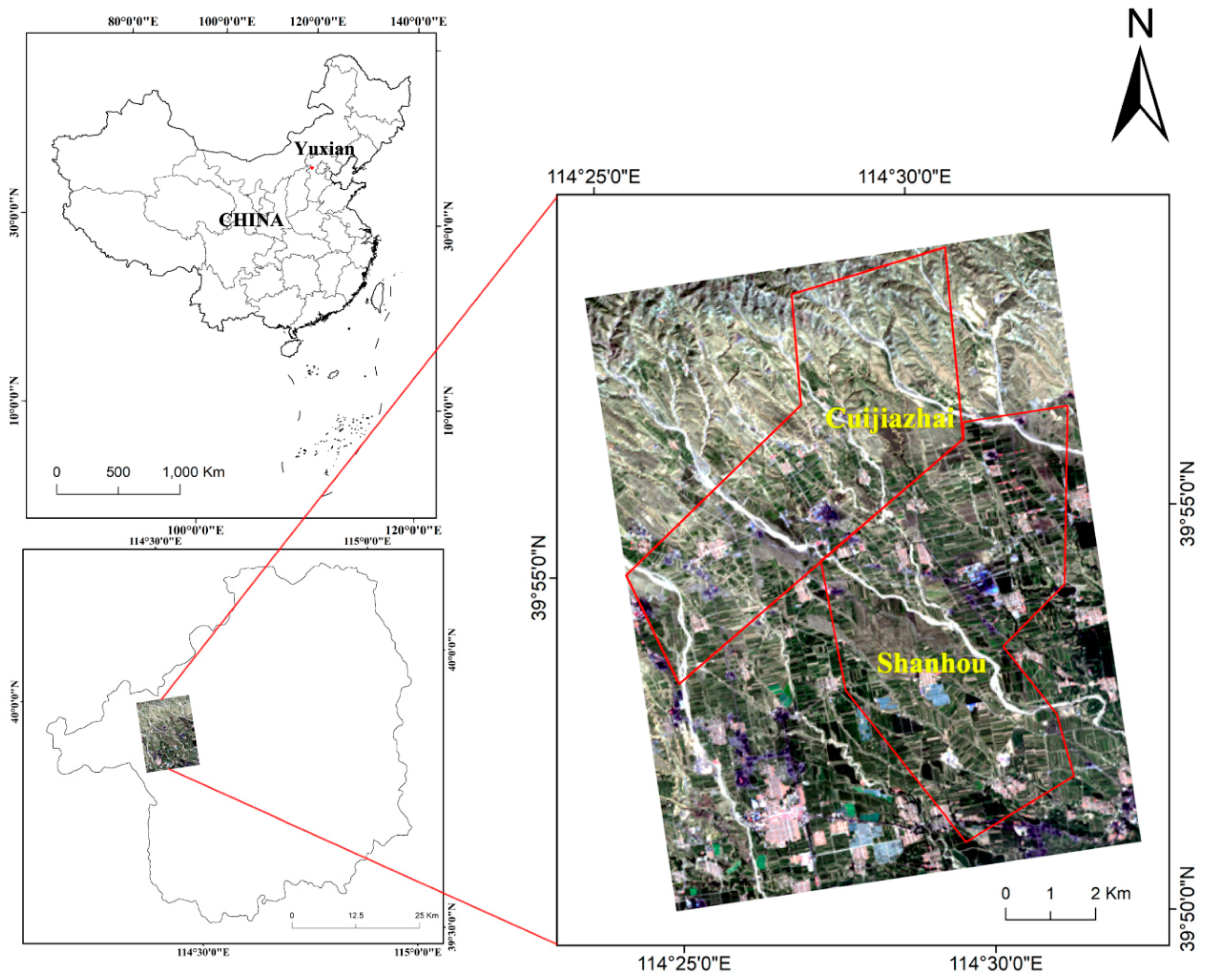

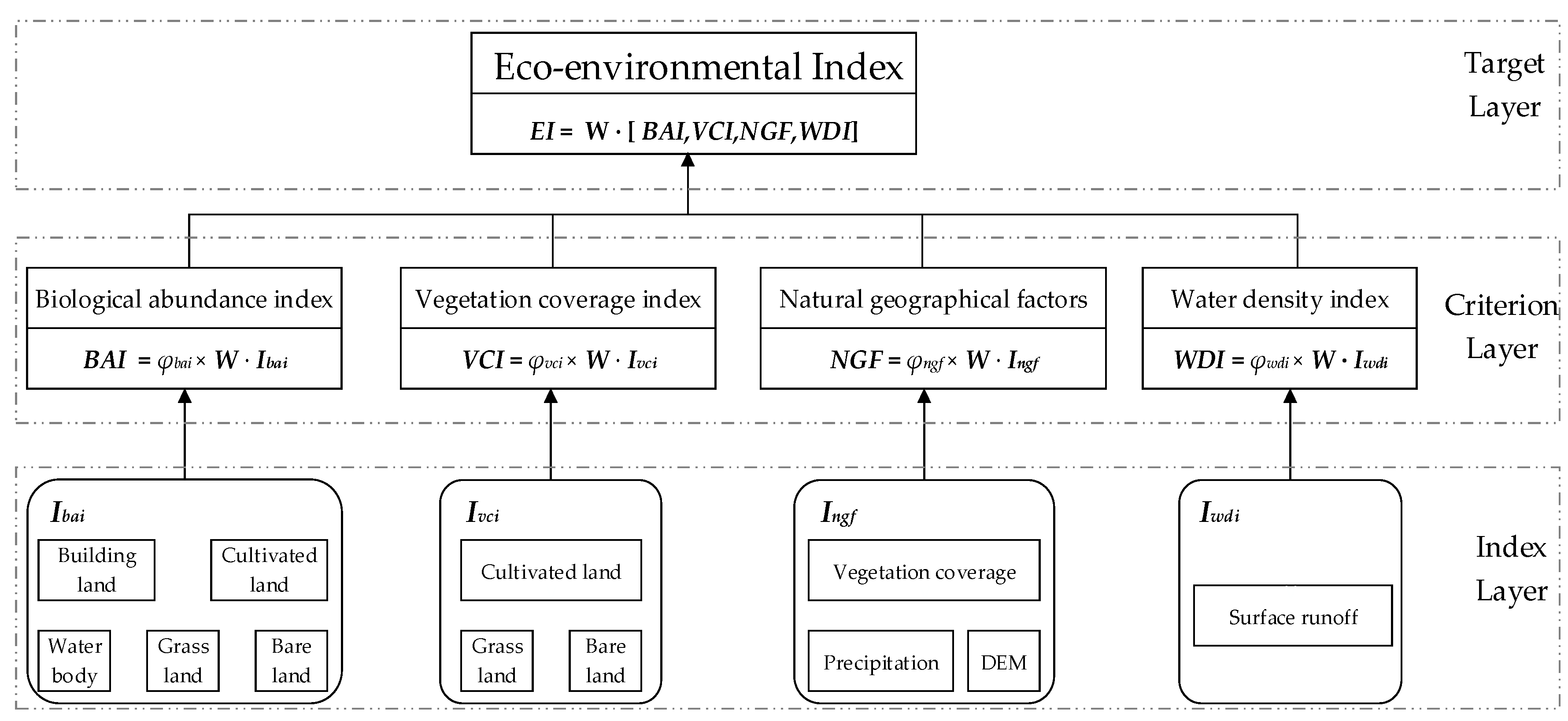

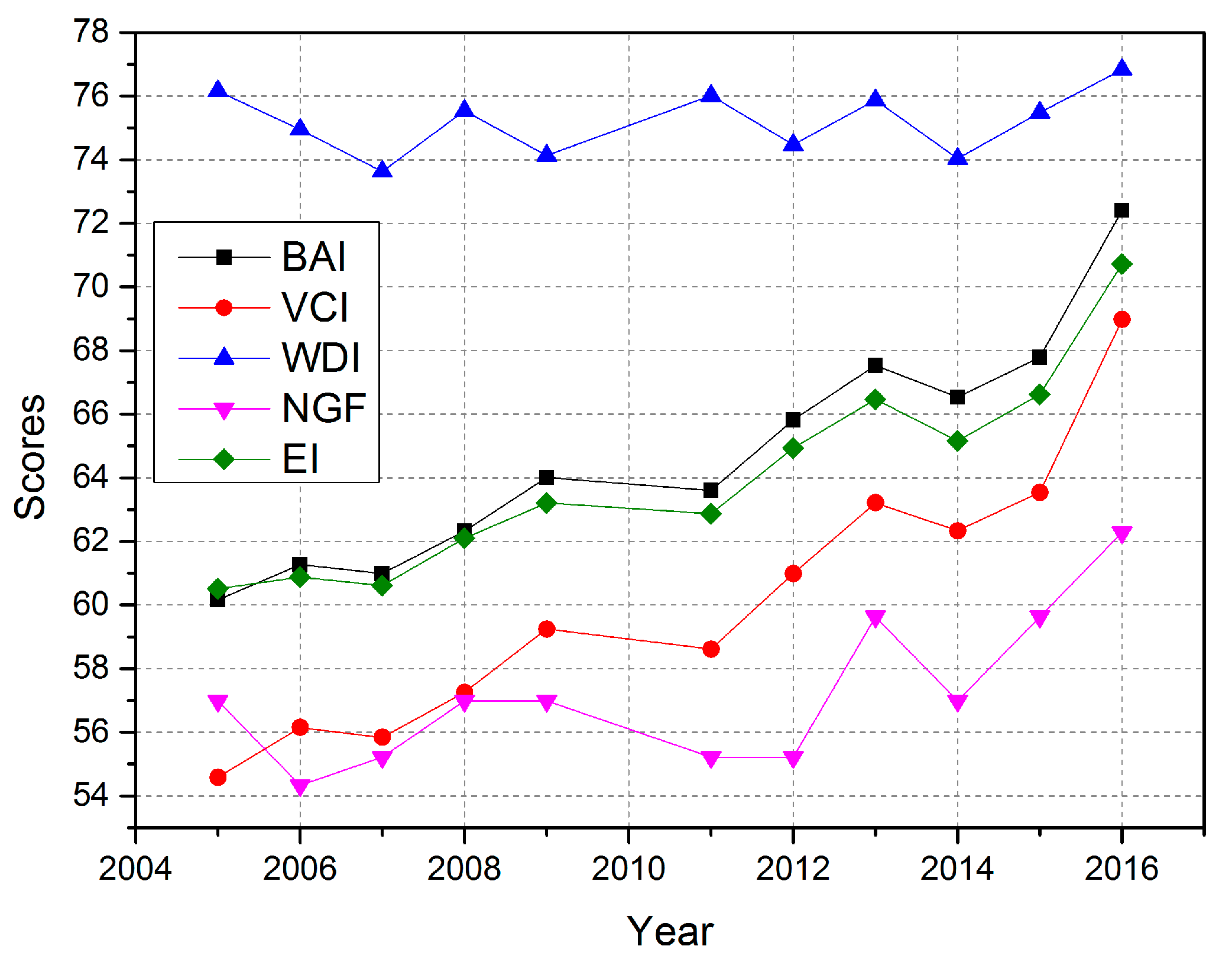

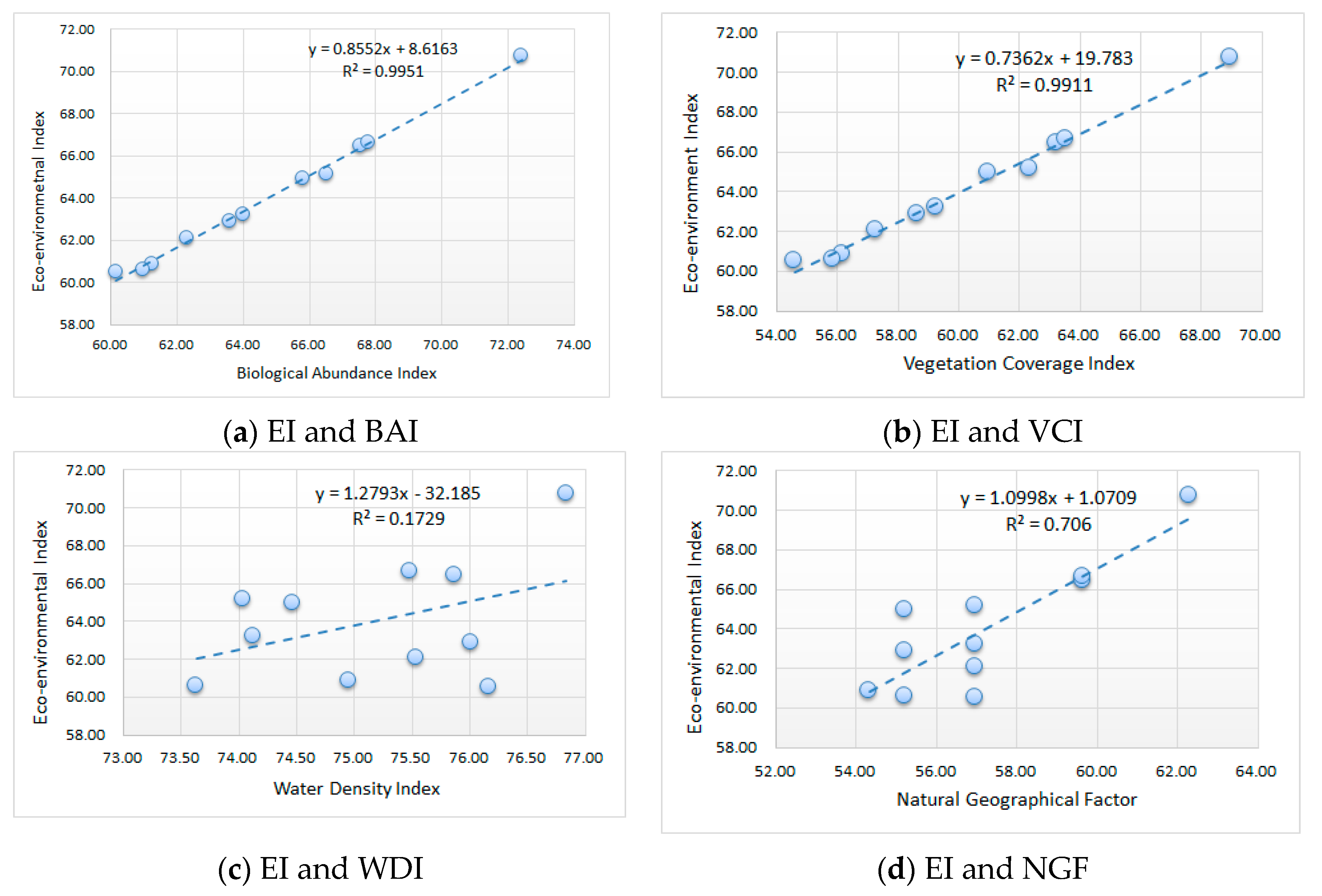
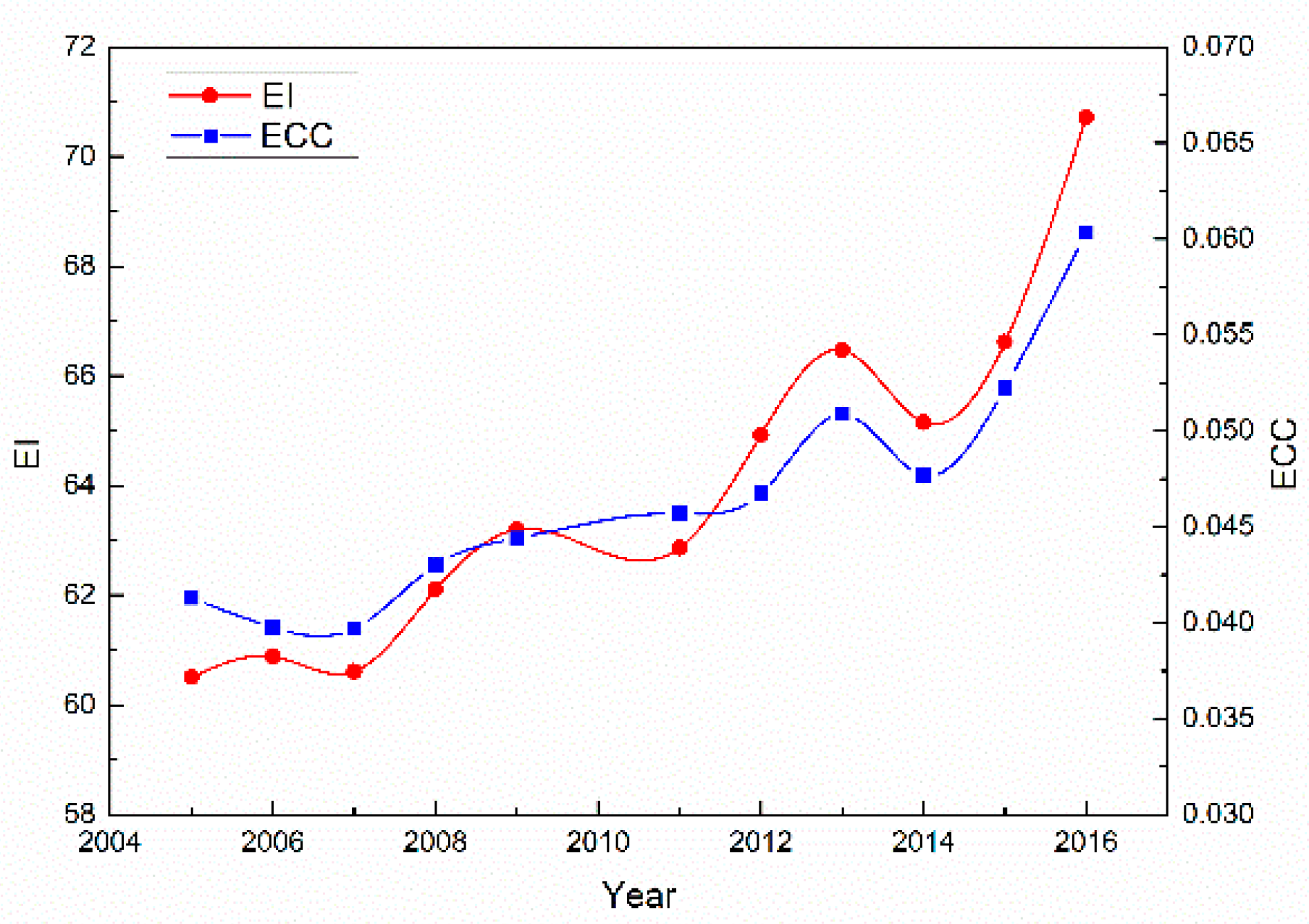
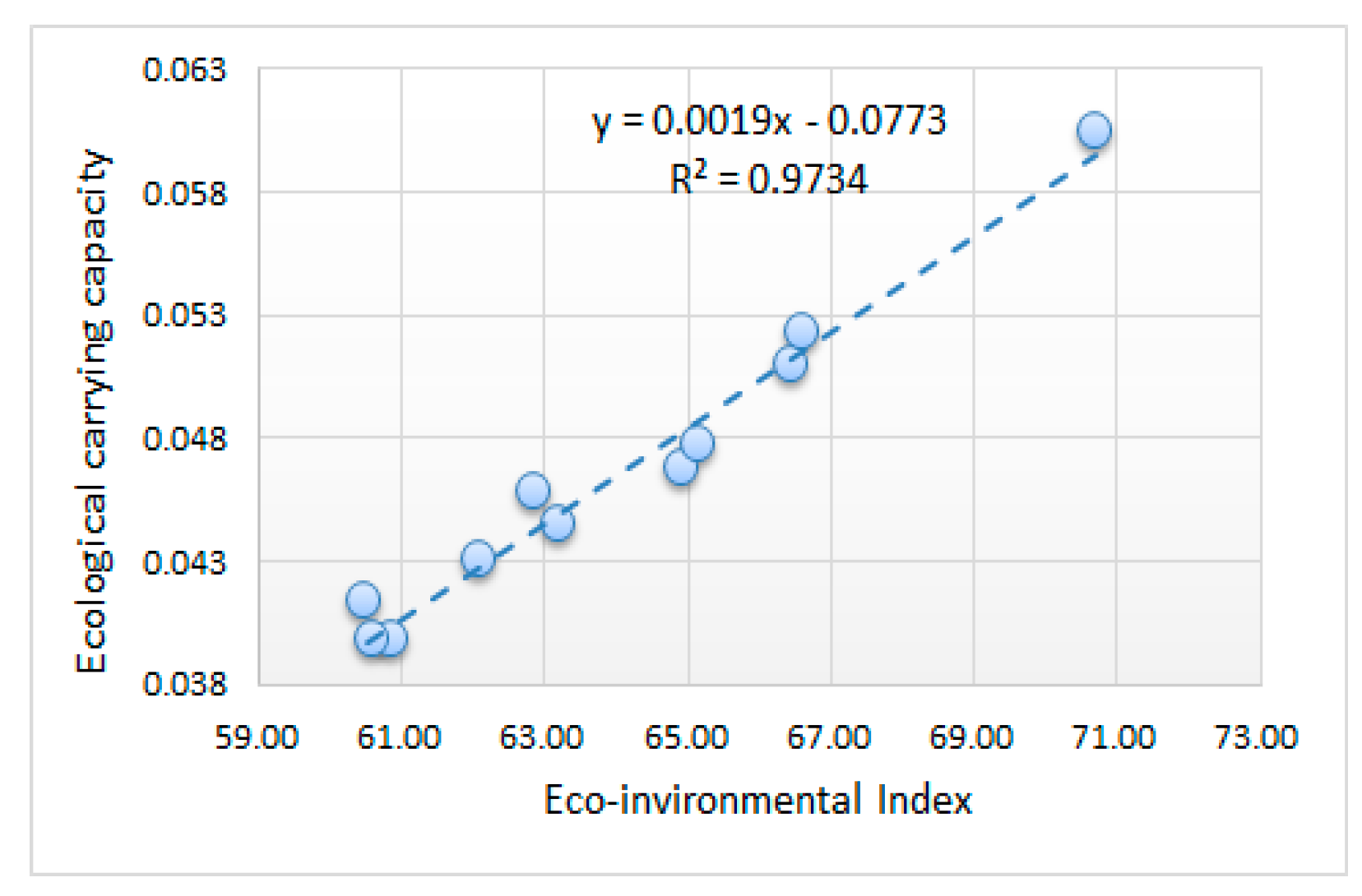
| Sensor | Date | Sensor | Date | Sensor | Date |
|---|---|---|---|---|---|
| ETM+ | 2005/04/03 | ETM+ | 2008/11/21 | OLI | 2013/09/15 |
| ETM+ | 2005/06/22 | ETM+ | 2009/02/09 | OLI | 2013/11/18 |
| ETM+ | 2005/09/17 | ETM+ | 2009/06/24 | OLI | 2014/03/10 |
| ETM+ | 2005/11/19 | ETM+ | 2009/09/21 | OLI | 2014/07/25 |
| ETM+ | 2006/03/05 | ETM+ | 2009/10/23 | OLI | 2014/09/27 |
| ETM+ | 2006/06/16 | ETM+ | 2011/05/22 | OLI | 2014/11/21 |
| ETM+ | 2006/09/29 | ETM+ | 2011/07/06 | OLI | 2015/03/13 |
| ETM+ | 2006/10/31 | ETM+ | 2011/09/11 | OLI | 2015/08/13 |
| ETM+ | 2007/02/20 | ETM+ | 2011/11/14 | OLI | 2015/09/14 |
| ETM+ | 2007/08/15 | ETM+ | 2012/02/18 | OLI | 2015/11/01 |
| ETM+ | 2007/09/23 | ETM+ | 2012/07/02 | OLI | 2016/03/24 |
| ETM+ | 2007/11/03 | ETM+ | 2012/08/28 | OLI | 2016/08/06 |
| ETM+ | 2008/03/10 | ETM+ | 2012/10/06 | OLI | 2016/08/31 |
| ETM+ | 2008/07/23 | ETM+ | 2013/03/15 | OLI | 2016/11/19 |
| ETM+ | 2008/09/02 | OLI | 2013/07/06 | _____ | _____ |
| Scene | Category | Building Land | Water Body | Cultivated Land | Grassland | Bare Land |
|---|---|---|---|---|---|---|
| 2016/03/24 | Building land | 108 | 0 | 0 | 0 | 0 |
| Water body | 0 | 65 | 0 | 0 | 0 | |
| Cultivated land | 0 | 0 | 57 | 0 | 0 | |
| Grassland | 1 | 1 | 0 | 322 | 13 | |
| Bare land | 0 | 0 | 0 | 4 | 112 | |
| User’s accuracies | 1 | 1 | 1 | 0.9555 | 0.9655 | |
| Producer’s accuracies | 0.9908 | 0.9848 | 1 | 0.9877 | 0.896 | |
| Commission | 0 | 0 | 0 | 0.0445 | 0.0345 | |
| Omission | 0.0092 | 0.0152 | 0 | 0.0123 | 0.104 | |
| 2016/08/06 | Building land | 108 | 0 | 0 | 0 | 0 |
| Water body | 0 | 65 | 0 | 0 | 0 | |
| Cultivated land | 0 | 0 | 57 | 0 | 0 | |
| Grassland | 1 | 1 | 0 | 322 | 13 | |
| Bare land | 0 | 0 | 0 | 4 | 112 | |
| User’s accuracies | 1 | 1 | 1 | 0.9555 | 0.9655 | |
| Producer’s accuracies | 0.9908 | 0.9848 | 1 | 0.9877 | 0.896 | |
| Commission | 0 | 0 | 0 | 0.0445 | 0.0345 | |
| Omission | 0.0092 | 0.0152 | 0 | 0.0123 | 0.104 | |
| 2016/08/31 | Building land | 108 | 0 | 0 | 0 | 0 |
| Water body | 0 | 65 | 0 | 0 | 0 | |
| Cultivated land | 0 | 0 | 57 | 0 | 0 | |
| Grassland | 1 | 1 | 0 | 322 | 13 | |
| Bare land | 0 | 0 | 0 | 4 | 112 | |
| User’s accuracies | 1 | 1 | 1 | 0.9555 | 0.9655 | |
| Producer’s accuracies | 0.9908 | 0.9848 | 1 | 0.9877 | 0.896 | |
| Commission | 0 | 0 | 0 | 0.0445 | 0.0345 | |
| Omission | 0.0092 | 0.0152 | 0 | 0.0123 | 0.104 | |
| 2016/11/19 | Building land | 108 | 0 | 0 | 0 | 0 |
| Water body | 0 | 65 | 0 | 0 | 0 | |
| Cultivated land | 0 | 0 | 57 | 0 | 0 | |
| Grassland | 1 | 1 | 0 | 322 | 13 | |
| Bare land | 0 | 0 | 0 | 4 | 112 | |
| User’s accuracies | 1 | 1 | 1 | 0.9555 | 0.9655 | |
| Producer’s accuracies | 0.9908 | 0.9848 | 1 | 0.9877 | 0.896 | |
| Commission | 0 | 0 | 0 | 0.0445 | 0.0345 | |
| Omission | 0.0092 | 0.0152 | 0 | 0.0123 | 0.104 |
| Index Layer | Computing Method |
|---|---|
| VBuilding land | Area of building land/Total area |
| VWater body | Area of water body/Total area |
| VCultivated land | Area of cultivated land/Total area |
| VBare land | Area of bare land/Total area |
| VGrass land | Area of grass land/Total area |
| VVegetation coverage | (Area of grass land + Area of cultivated land)/Total area |
| VPrecipitation | The value of precipitation |
| VDEM | The value of DEM |
| VSurgace runoff | The value of water body |
| Numerical Rating | Verbal Judgment of Preference |
|---|---|
| 1 | Equally preferred |
| 3 | Moderately preferred |
| 5 | Strongly preferred |
| 7 | Very strongly preferred |
| 9 | Extremely strongly preferred |
| 2, 4, 6, 8 | The adjacent middle value judgment |
| inversion | Comparison of factor to is b, while the factor to comparison scale is 1/b |
| Number of Indices | 2 | 3 | 4 | 5 | 6 | 7 | 8 | 9 | 10 |
|---|---|---|---|---|---|---|---|---|---|
| RI | 0 | 0.58 | 0.90 | 1.12 | 1.24 | 1.32 | 1.41 | 1.45 | 1.49 |
| Land Type | Main Purpose | Balance Factor | Yield Factor |
|---|---|---|---|
| Cultivated land | Crop cultivation | 1.10 | 0.91 |
| Forest land | Providing forest products and wood | 0.67 | 0.69 |
| Grassland | Providing animal by-products | 0.48 | 1.55 |
| Building land | Land for human settlement | 1.10 | 1.55 |
| Productive water | Providing aquatic products | 0.38 | 0.91 |
| Energy land | Absorbing CO2 released by humans | 0.67 | 0.00 |
| Target Layer | Criterion Layer | Criterion Weight | Index Layer | Index Weight |
|---|---|---|---|---|
| Eco-environmental Index | Biological abundance index | 0.46 | Water body | 0.42 |
| Building land | 0.10 | |||
| Cultivated land | 0.16 | |||
| Grassland | 0.26 | |||
| Bare land | 0.06 | |||
| Vegetation coverage index | 0.26 | Cultivated land | 0.32 | |
| Grassland | 0.56 | |||
| Bare land | 0.12 | |||
| Natural geographical factors | 0.14 | Precipitation | 0.19 | |
| DEM | 0.28 | |||
| Vegetation coverage | 0.58 | |||
| Water density index | 0.14 | Surface runoff | 1.00 |
| Year | BAI | VCI | WDI | NGF | EI |
|---|---|---|---|---|---|
| 2005 | 60.16 | 54.58 | 76.16 | 56.98 | 60.50 |
| 2006 | 61.27 | 56.15 | 74.95 | 54.33 | 60.88 |
| 2007 | 60.99 | 55.83 | 73.63 | 55.21 | 60.61 |
| 2008 | 62.32 | 57.25 | 75.53 | 56.98 | 62.10 |
| 2009 | 64.00 | 59.25 | 74.13 | 56.98 | 63.20 |
| 2011 | 63.60 | 58.61 | 76.02 | 55.21 | 62.87 |
| 2012 | 65.82 | 60.98 | 74.47 | 55.21 | 64.93 |
| 2013 | 67.53 | 63.21 | 75.87 | 59.63 | 66.47 |
| 2014 | 66.53 | 62.33 | 74.03 | 56.98 | 65.15 |
| 2015 | 67.78 | 63.54 | 75.48 | 59.63 | 66.62 |
| 2016 | 72.40 | 68.97 | 76.84 | 62.28 | 70.71 |
| Level | Excellent | Good | General | Poor | Bad |
|---|---|---|---|---|---|
| Value range | 75 | EI 75 | 35 EI 55 | 20 EI 35 | EI 20 |
| State | Vegetation coverage and greenness is excellent; the ecosystem is suitable for human survival | Vegetation coverage and greenness is good; the ecosystem is suitable for human survival | Vegetation coverage and greenness is average; the ecosystem is suitable for human survival but there are factors that are not suitable for human survival | Vegetation coverage is poor; severe drought; fewer species; there are obvious factors that are not suitable for human survival | The situation is bad; desert, saline or alpine region all around; environmental degradation |
| Level | No clear Change | Slight Change | Clear Change | Significant Change |
|---|---|---|---|---|
| Change value | ||||
| State | There is no clear change in the ecological environment | If the eco-environment is slightly better, if −, the eco-environment is slightly worse. | If the eco-environment is clearly better, if −, the eco-environment is clearly worse. | If the eco-environment is significantly better, if −, the eco-environment is clearly worse. |
| Land Type | Cultivated Land | Grassland | Water Body | Building Land | Total | |
|---|---|---|---|---|---|---|
| Per capita area (hm2/cap) | 2005 | 0.0158 | 0.0210 | 0.0064 | 0.0116 | 0.0549 |
| 2006 | 0.0097 | 0.0263 | 0.0063 | 0.0122 | 0.0545 | |
| 2007 | 0.0098 | 0.0259 | 0.0062 | 0.0124 | 0.0542 | |
| 2008 | 0.0115 | 0.0271 | 0.0063 | 0.0134 | 0.0584 | |
| 2009 | 0.0118 | 0.0305 | 0.0062 | 0.0123 | 0.0608 | |
| 2011 | 0.0153 | 0.0277 | 0.0064 | 0.0123 | 0.0616 | |
| 2012 | 0.0123 | 0.0331 | 0.0066 | 0.0122 | 0.0643 | |
| 2013 | 0.0156 | 0.0353 | 0.0064 | 0.0122 | 0.0695 | |
| 2014 | 0.0103 | 0.0361 | 0.0062 | 0.0133 | 0.0659 | |
| 2015 | 0.0147 | 0.0358 | 0.0063 | 0.0142 | 0.0711 | |
| 2016 | 0.0158 | 0.0434 | 0.0064 | 0.0167 | 0.0823 | |
| Land Type | Cultivated Land | Grassland | Water Body | Building Land | Total | |
|---|---|---|---|---|---|---|
| Per capita ecological carrying capacity (hm2/cap) | 2005 | 0.0139 | 0.0138 | 0.0033 | 0.0103 | 0.0413 |
| 2006 | 0.0085 | 0.0172 | 0.0033 | 0.0107 | 0.0398 | |
| 2007 | 0.0086 | 0.0169 | 0.0032 | 0.0109 | 0.0397 | |
| 2008 | 0.0102 | 0.0178 | 0.0033 | 0.0118 | 0.0430 | |
| 2009 | 0.0104 | 0.0199 | 0.0032 | 0.0108 | 0.0444 | |
| 2011 | 0.0134 | 0.0181 | 0.0033 | 0.0108 | 0.0457 | |
| 2012 | 0.0108 | 0.0217 | 0.0034 | 0.0108 | 0.0467 | |
| 2013 | 0.0137 | 0.0231 | 0.0033 | 0.0107 | 0.0509 | |
| 2014 | 0.0091 | 0.0236 | 0.0032 | 0.0118 | 0.0477 | |
| 2015 | 0.0146 | 0.0263 | 0.0037 | 0.0141 | 0.0522 | |
| 2016 | 0.0139 | 0.0284 | 0.0033 | 0.0147 | 0.0604 | |
© 2019 by the authors. Licensee MDPI, Basel, Switzerland. This article is an open access article distributed under the terms and conditions of the Creative Commons Attribution (CC BY) license (http://creativecommons.org/licenses/by/4.0/).
Share and Cite
Wang, X.; Tan, K.; Xu, K.; Chen, Y.; Ding, J. Quantitative Evaluation of the Eco-Environment in a Coalfield Based on Multi-Temporal Remote Sensing Imagery: A Case Study of Yuxian, China. Int. J. Environ. Res. Public Health 2019, 16, 511. https://doi.org/10.3390/ijerph16030511
Wang X, Tan K, Xu K, Chen Y, Ding J. Quantitative Evaluation of the Eco-Environment in a Coalfield Based on Multi-Temporal Remote Sensing Imagery: A Case Study of Yuxian, China. International Journal of Environmental Research and Public Health. 2019; 16(3):511. https://doi.org/10.3390/ijerph16030511
Chicago/Turabian StyleWang, Xue, Kun Tan, Kailei Xu, Yu Chen, and Jianwei Ding. 2019. "Quantitative Evaluation of the Eco-Environment in a Coalfield Based on Multi-Temporal Remote Sensing Imagery: A Case Study of Yuxian, China" International Journal of Environmental Research and Public Health 16, no. 3: 511. https://doi.org/10.3390/ijerph16030511
APA StyleWang, X., Tan, K., Xu, K., Chen, Y., & Ding, J. (2019). Quantitative Evaluation of the Eco-Environment in a Coalfield Based on Multi-Temporal Remote Sensing Imagery: A Case Study of Yuxian, China. International Journal of Environmental Research and Public Health, 16(3), 511. https://doi.org/10.3390/ijerph16030511






